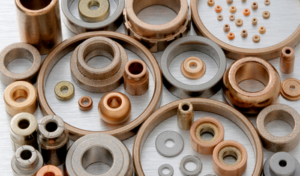The speed supported by sintered bearings may vary depending on the specific model, design, and application. Generally speaking, sintered iron and sintered bronze bearings can usually support speeds of several hundred to several thousand RPM. For example, sintered bronze bearings can usually handle speeds up to about 3000RPM, while sintered iron bearings can sometimes handle speeds up to about 2000RPM.
Sintered bearings are a special type of bearing that compresses and heats metal powder under incomplete melting at high temperatures, increasing its density and forming uniform micropores. The bearings produced by this process have one of the excellent characteristics – self-lubrication. Sintered bearings are usually made of sintered iron or sintered bronze. However, there are differences in the ability of these two materials to support rotational speed (RPM).
RPM is an abbreviation for “revolutions per minute”, used to measure how quickly a machine component undergoes a complete rotation. RPM is usually used to describe the maximum rotational speed that a bearing can withstand.

Sintered iron bearings can operate in the range of 500 to 3000 RPM. This ability makes sintered iron bearings stand out in environments that require continuous high-speed operation, such as in motors and gearboxes.
Due to the excellent thermal conductivity and corrosion resistance of bronze itself, sintered bronze bearings can be used in a wider range of temperatures and environments, and can provide speeds of 250 to 4500 RPM. This makes this type of bearing suitable for applications that require continuous operation or work in more demanding environments, such as in the automotive and heavy-duty machinery industries.
However, these speed values are not fixed, and many factors such as design, load, lubrication, and environmental conditions can affect the maximum supported speed of sintered bearings. Therefore, in order to ensure the optimal matching of bearing performance, it is usually necessary to consult the manufacturer or supplier for specific application requirements to achieve optimal performance.
Overall, both sintered iron bearings and sintered bronze bearings provide reliable speed support, but the suitable applications may vary. These bearings are common because they provide opportunities and flexibility for various designs and applications with different needs. This diversity and plasticity make sintered bearings an indispensable part of many industries, and there is still broad application space in future industrial development.
Thank you for reading our article. If you need related products or have any questions or suggestions about our products, please don’t hesitate to contact us by sending an email, and we will reply to your email as soon as possible.

